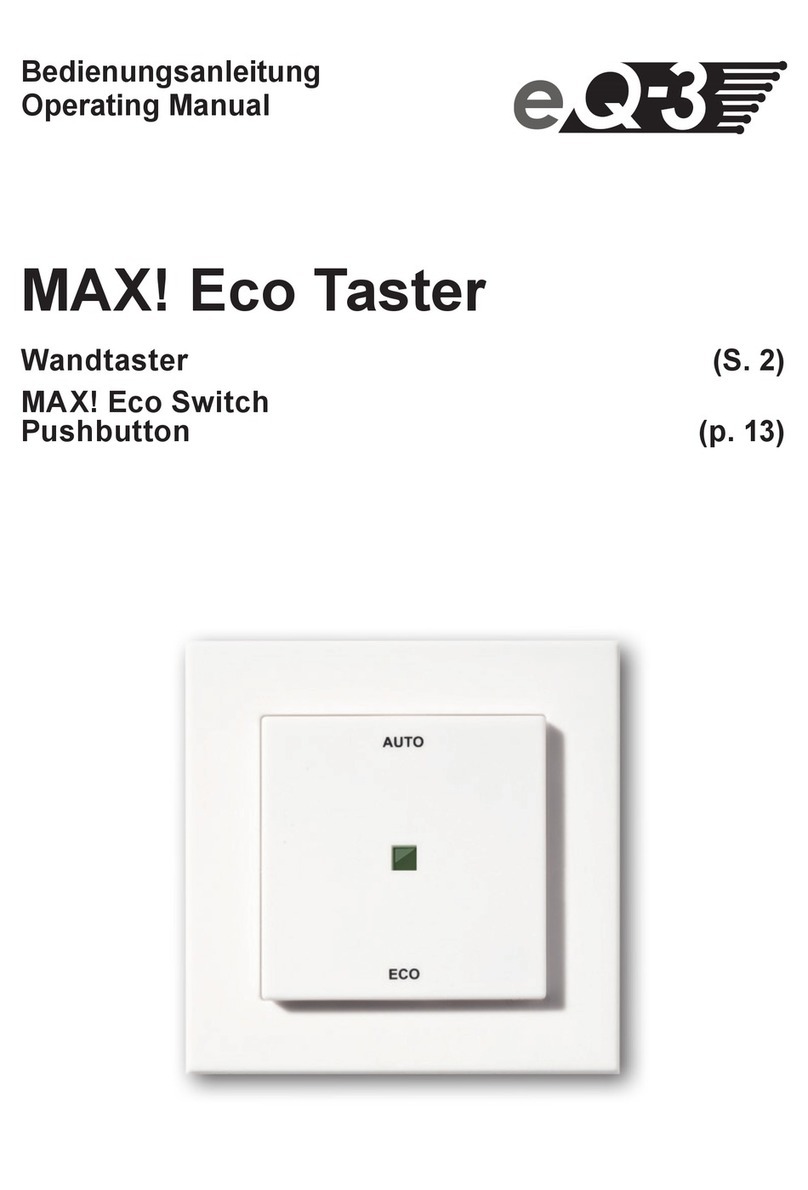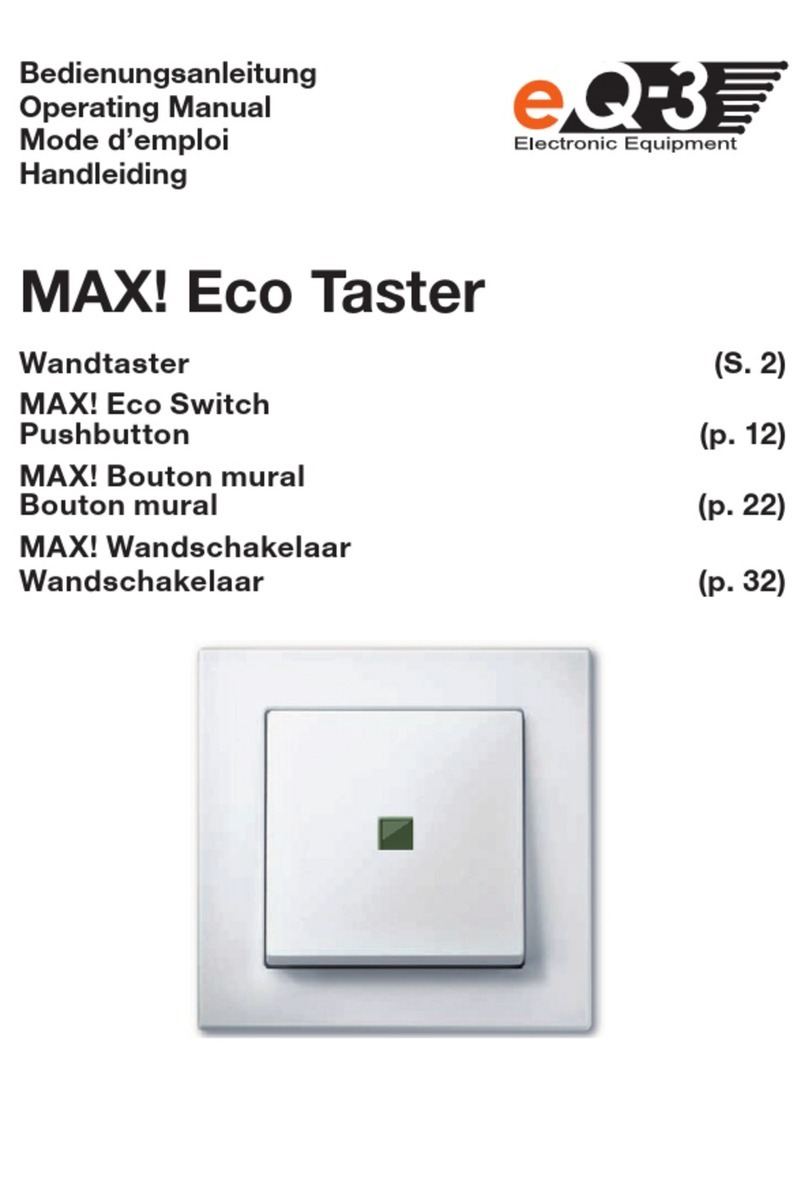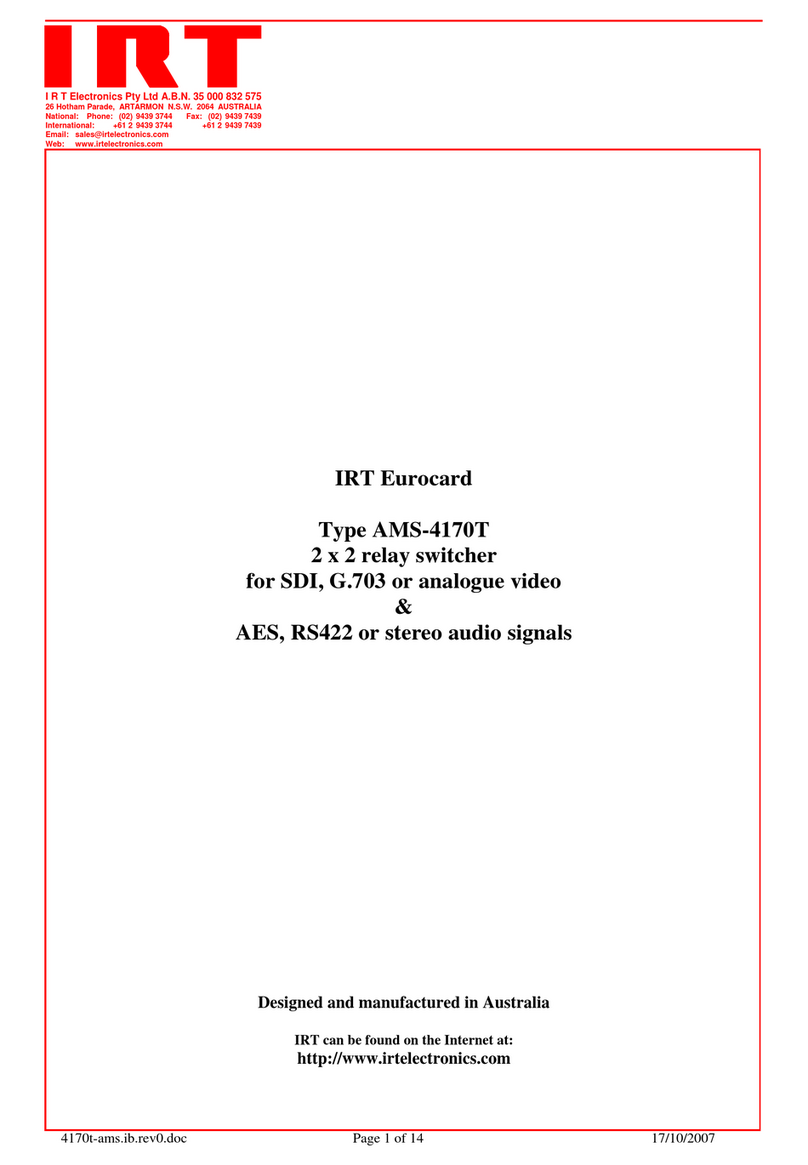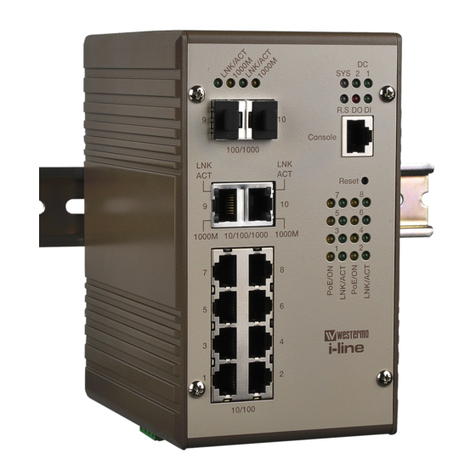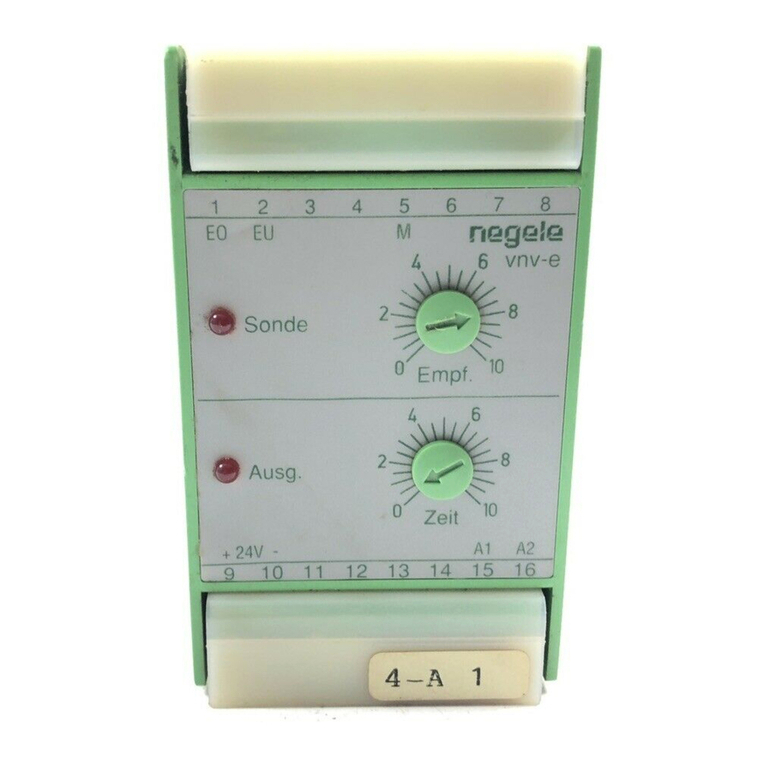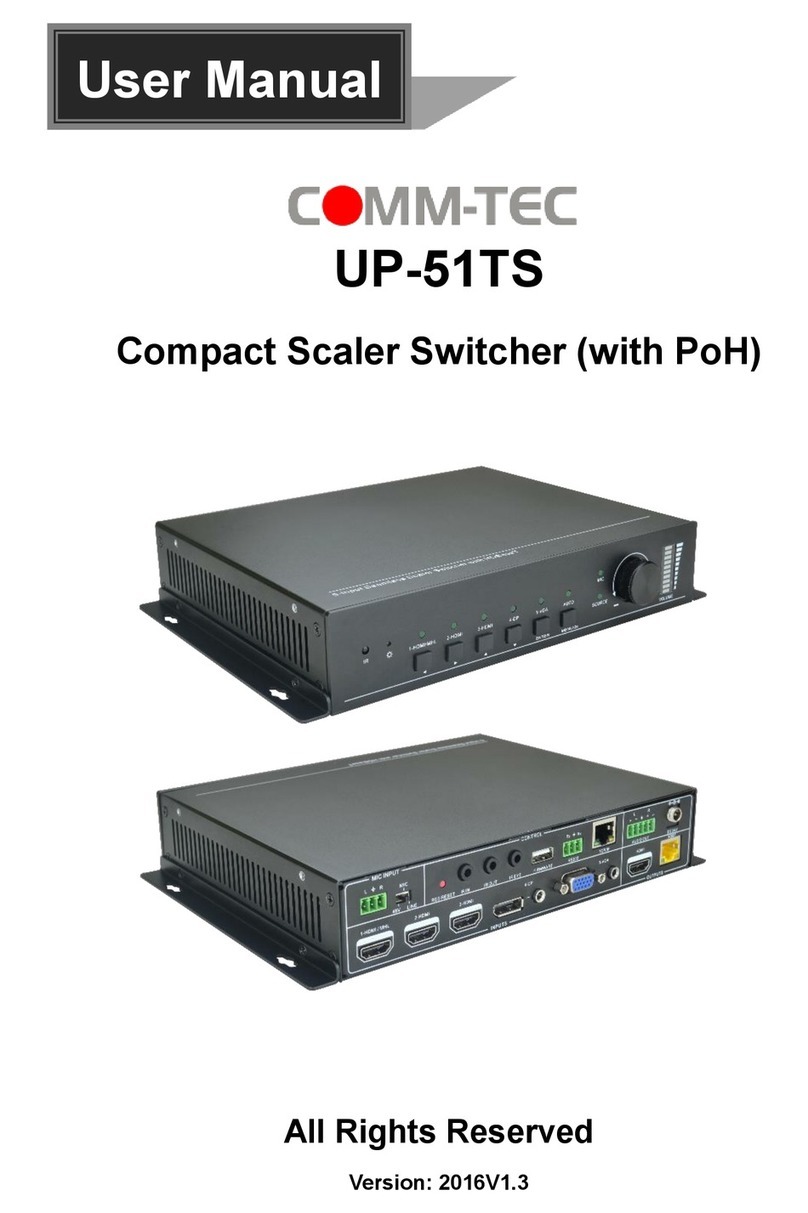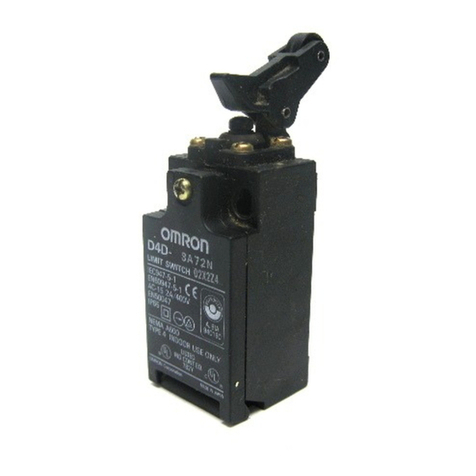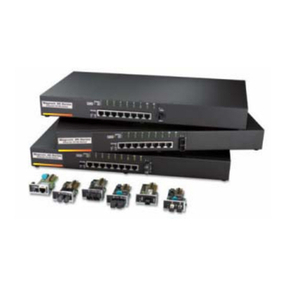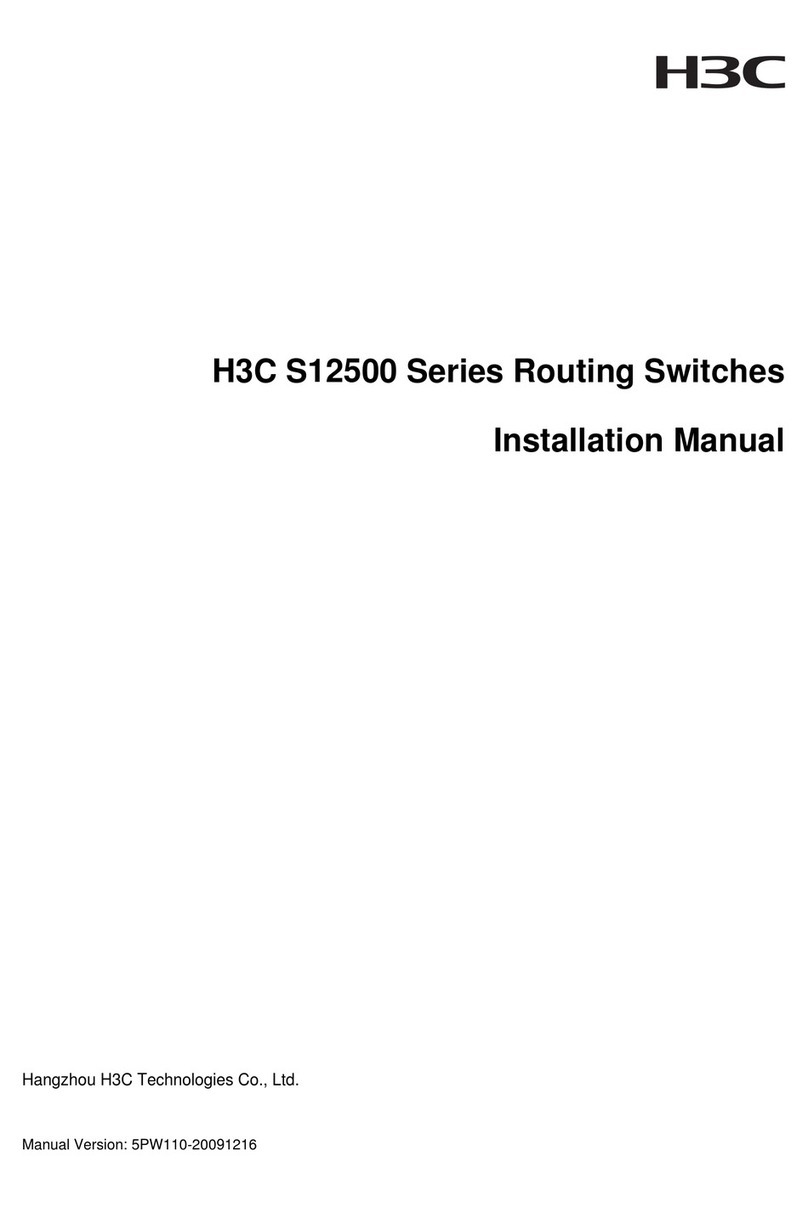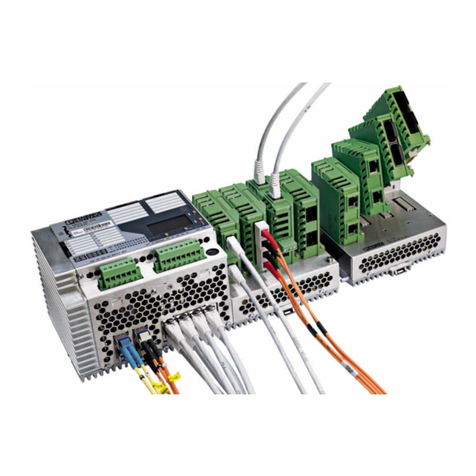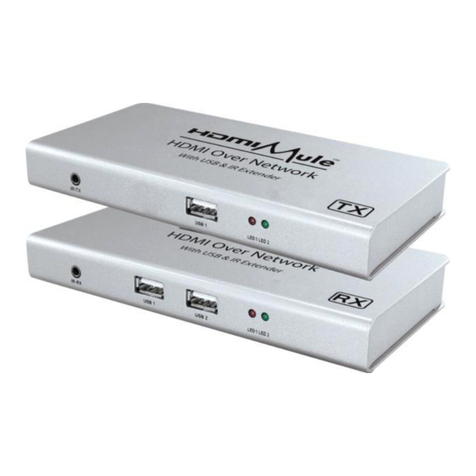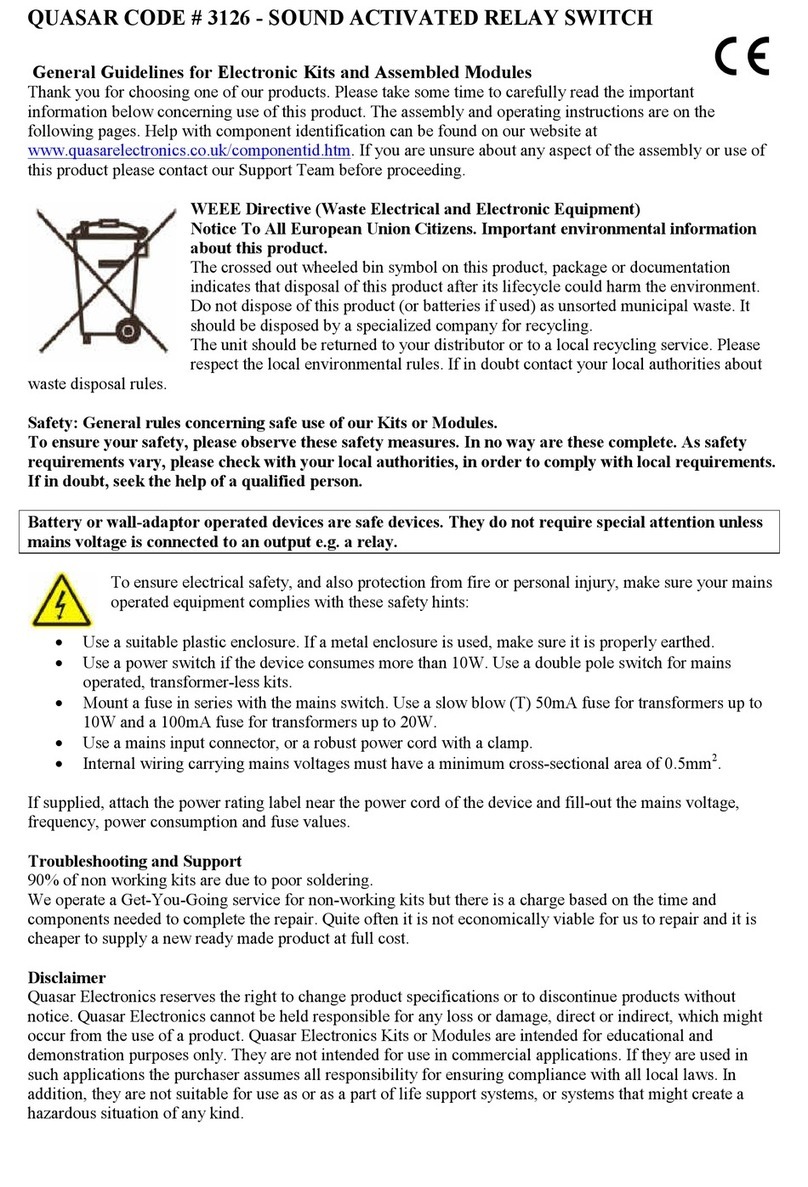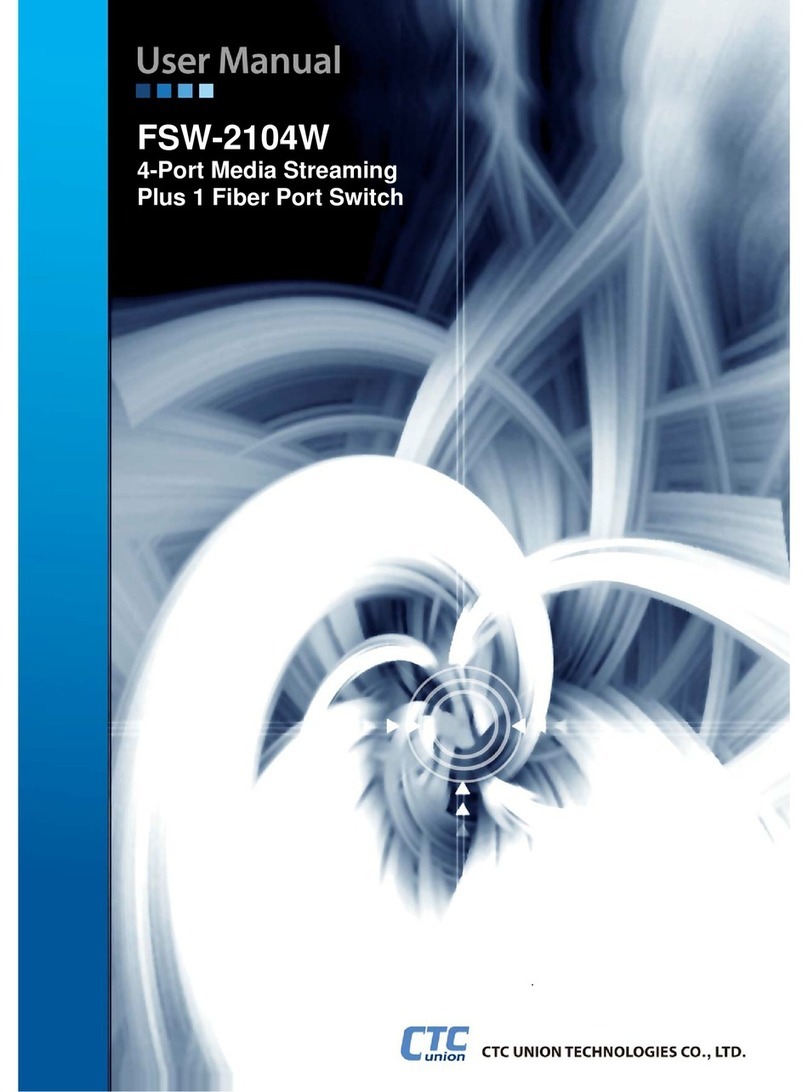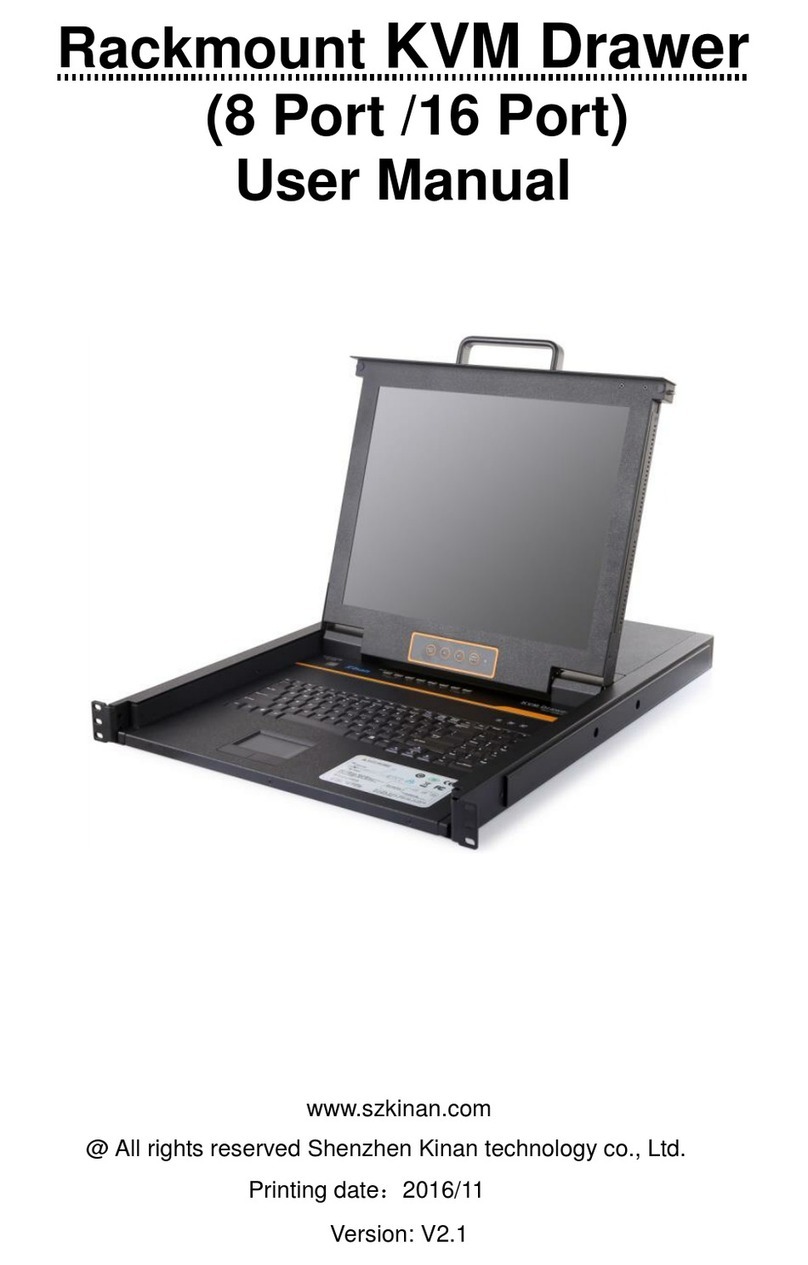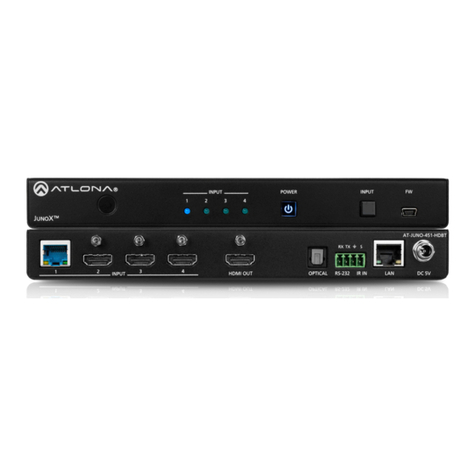EQ3 HomeMatic HM-LC-Sw1-Pl-DN-R5 User manual

Bedienungsanleitung S. 2
Operating Manual p. 19
Mode d’emploi p. 36
Istruzioni per l’uso p. 54
Funk-Schaltaktor 1-fach,
Zwischenstecker Typ J
Wireless Switch Actuator 1-channel,
plug adapter type J
Actionneur de commutation sans l à 1 canal,
adaptateur type J
Attuatore radio singolo,
spina intermedia tipo J
HM-LC-Sw1-Pl-DN-R5

23
Lieferumfang
Anzahl Artikel
1x HomeMatic Funk-Schaltaktor 1-fach, Zwischenstecker
Typ J
1x Bedienungsanleitung
1. Ausgabe Deutsch 10/2014
Dokumentation © 2014 eQ-3 AG, Deutschland
Alle Rechte vorbehalten. Ohne schriftliche Zustimmung des Heraus-
gebers darf dieses Handbuch auch nicht auszugsweise in irgendei-
ner Form reproduziert werden oder unter Verwendung elektronischer,
mechanischer oder chemischer Verfahren vervielfältigt oder verarbeitet
werden.
Es ist möglich, dass das vorliegende Handbuch noch drucktechnische
Mängel oder Druckfehler aufweist. Die Angaben in diesem Handbuch
werden jedoch regelmäßig überprüft und Korrekturen in der nächsten
Ausgabe vorgenommen. Für Fehler technischer oder drucktechnischer
Art und ihre Folgen übernehmen wir keine Haftung.
Alle Warenzeichen und Schutzrechte werden anerkannt.
Printed in Hong Kong
Änderungen im Sinne des technischen Fortschritts können ohne Vo-
rankündigung vorgenommen werden.
141158 / V 1.1
Inhaltsverzeichnis
1 Hinweise zu dieser Anleitung ...........................4
2 Gefahrenhinweise ...................................4
3 Funktion und Geräteübersicht ..........................7
4 Allgemeine Systeminformation zu HomeMatic..............8
5 Inbetriebnahme .....................................8
5.1 Einfache Bedienfunktionen am Gerät.....................8
5.2 Anlernen...........................................8
5.2.1 Anlernen an HomeMatic Geräte.........................9
5.2.2 Anlernen an eine HomeMatic Zentrale...................10
6 Bedienung ........................................13
7 Werkseinstellungen wiederherstellen....................14
8 Fehler- und Rückmeldungen der Geräte-LED . . . . . . . . . . . . .14
8.1 Blinkcodes ........................................14
8.2 Anzeige des Betriebszustandes........................15
8.3 Duty Cycle ........................................15
9 Verhalten nach Spannungswiederkehr...................16
10 Wartung und Reinigung ..............................16
11 Allgemeine Hinweise zum Funkbetrieb ..................17
12 Technische Daten...................................17

45
Hinweise zu dieser Anleitung Gefahrenhinweise
1 Hinweise zu dieser Anleitung
Lesen Sie diese Anleitung sorgfältig, bevor Sie Ihre HomeMatic Kom-
ponenten in Betrieb nehmen. Bewahren Sie die Anleitung zum spä-
teren Nachschlagen auf! Wenn Sie das Gerät anderen Personen zur
Nutzung überlassen, übergeben Sie auch diese Bedienungsanleitung.
Benutzte Symbole:
Achtung! Hier wird auf eine Gefahr hingewiesen.
Hinweis. Dieser Abschnitt enthält zusätzliche wichtige
Informationen!
Hinweis. Dieser Abschnitt enthält zusätzliche wichtige
Informationen zur Verwendung des Gerätes in Verbindung mit
der HomeMatic Zentrale.
2 Gefahrenhinweise
Bei Sach- oder Personenschäden, die durch unsachgemäße
Handhabung oder Nichtbeachten der Gefahrenhinweise
verursacht werden, übernehmen wir keine Haftung. In solchen
Fällen erlischt jeder Gewährleistungsanspruch! Für Folgeschä-
den übernehmen wir keine Haftung!
Öffnen Sie das Gerät nicht. Es enthält keine durch den
Anwender zu wartenden Teile. Das Öffnen des Gerätes birgt
die Gefahr eines Stromschlages. Im Fehlerfall lassen Sie das
Gerät von einer Fachkraft prüfen.
Verwenden Sie das Gerät nicht, wenn es von außen erkennbare
Schäden z. B. am Gehäuse, an Bedienelementen oder an den
Anschlussbuchsen bzw. eine Funktionsstörung aufweist. Lassen
Sie das Gerät im Zweifelsfall von einer Fachkraft prüfen.
Aus Sicherheits- und Zulassungsgründen (CE) ist das
eigenmächtige Umbauen und/oder Verändern des Produkts
nicht gestattet.
Betreiben Sie das Gerät nur in Innenräumen und setzen Sie es
keinem Einuss von Feuchtigkeit, Vibrationen, ständiger
Sonnen- oder anderer Wärmeeinstrahlung, Kälte und keinen
mechanischen Belastungen aus.
Das Gerät ist kein Spielzeug, erlauben Sie Kindern nicht damit
zu spielen. Lassen Sie das Verpackungsmaterial nicht achtlos
liegen, Plastikfolien/-tüten, Styroporteile, etc., könnten für
Kinder zu einem gefährlichen Spielzeug werden.
Beachten Sie vor Anschluss eines Verbrauchers die tech-
nischen Daten, insbesondere die maximal zulässige Schaltlei-
stung des Relais und Art des anzuschließenden Verbrauchers!
Alle Lastangaben beziehen sich auf ohmsche Lasten! Belasten
Sie das Gerät nur bis zur angegebenen Leistungsgrenze. Eine
Überlastung kann zur Zerstörung des Gerätes, zu einem Brand
oder elektrischen Unfall führen.
Das Gerät darf nur an eine leicht zugängliche Netz-Steckdose
angeschlossen werden. Bei Gefahr ist das Gerät aus der
Netz-Steckdose zu ziehen.
Verwenden Sie den HomeMatic Zwischenstecker nur in fest
installierten Steckdosen mit Schutzkontakten, nicht in
Steckdosenleisten oder mit Verlängerungskabeln.
Schließen Sie keine Endgeräte an den HomeMatic Zwischen-
stecker an, deren unbeaufsichtigtes Einschalten Brände oder
andere Schäden verursachen könnte (z. B. Bügeleisen).
Ziehen Sie grundsätzlich den Stecker des Endgerätes aus dem
HomeMatic Zwischenstecker, bevor Sie Veränderungen am

67
Gefahrenhinweise Funktion und Geräteübersicht
Endgerät vornehmen (z. B. Glühlampenwechsel).
Verlegen Sie Kabel stets so, dass diese nicht zu Gefährdungen
für Menschen und Haustiere führen können.
Das Gerät ist nicht zum Freischalten geeignet. Die Last ist
nicht galvanisch vom Netz getrennt.
Reinigen Sie das Gerät nur nach Entfernen aus der Steckdose
mit einem trockenen Leinentuch, das bei starken Verschmut-
zungen leicht angefeuchtet sein kann. Verwenden Sie zur
Reinigung keine lösemittelhaltigen Reinigungsmittel. Achten
Sie darauf, dass keine Feuchtigkeit in das Geräteinnere
gelangt.
Jeder andere Einsatz als der in dieser Bedienungsanleitung
beschriebene ist nicht bestimmungsgemäß und führt zu
Gewährleistungs- und Haftungsausschluss. Dies gilt auch für
Umbauten und Veränderungen. Das Gerät ist ausschließlich
für den privaten Gebrauch gedacht.
HomeMatic Zwischenstecker dürfen nicht hintereinander
gesteckt werden.
Geräte mit elektronischen Netzteilen (z. B. Fernseher oder
Hochvolt-LED-Leuchtmittel) stellen keine ohmschen Lasten
dar. Sie können Einschaltströme von über 100 A erzeugen.
Schalten solcher Verbraucher führt zu vorzeitigem Verschleiß
des Aktors.
Das Gerät ist nur für den Einsatz in wohnungsähnlichen
Umgebungen geeignet.
3 Funktion und Geräteübersicht
Der HomeMatic Funk-Schaltaktor 1-fach, Zwischenstecker ermöglicht
das Schalten von angeschlossenen Geräten per Funk.
Das Gerät kann schnell und ohne Werkzeug montiert werden und ist
nach dem Einstecken in die Steckdose sofort betriebsbereit. Mit dem
Funk-Schaltaktor ist sowohl eine einfache Bedienung am Gerät als
auch das Anlernen von mehreren HomeMatic Geräten (z. B. Home-
Matic Funk-Fernbedienung) möglich. Die Geräte-LED signalisiert z. B.
Betriebszustände und Fehlermeldungen.
In Verbindung mit der HomeMatic Zentrale CCU2 kann der Funk-
Schaltaktor über die WebUI Bedienoberäche individuell konguriert
und der volle Funktionsumfang genutzt werden. Sie können bspw. die
maximale Ein- bzw. Ausschaltdauer des Gerätes sowie eine Verzöge-
rungszeit für das Ein- bzw. Ausschalten angeschlossener Verbraucher
einstellen.
B
A
(A) - Kanaltaste
(B) - Geräte-LED

89
Allgemeine Systeminformation zu HomeMatic Inbetriebnahme
4 Allgemeine Systeminformation zu
HomeMatic
Dieses Gerät ist Teil des HomeMatic Haussteuersystems und arbeitet
mit dem bidirektionalen BidCoS®Funkprotokoll.
Alle Geräte werden mit einer Standardkonguration ausgeliefert. Da-
rüber hinaus ist die Funktion des Gerätes über ein Programmiergerät
und Software kongurierbar. Welcher weitergehende Funktionsumfang
sich damit ergibt, und welche Zusatzfunktionen sich im HomeMatic
System im Zusammenspiel mit weiteren Komponenten ergeben, ent-
nehmen Sie bitte dem HomeMatic WebUI Handbuch.
Alle technischen Dokumente und Updates nden Sie stets aktuell im
Downloadbereich unter www.homematic.com.
5 Inbetriebnahme
5.1 Einfache Bedienfunktionen am Gerät
• Stecken Sie den Funk-Schaltaktor in die Steckdose.
Das Gerät ist sofort betriebsbereit und kann an eine HomeMatic Zen-
trale (oder an andere HomeMatic Geräte) angelernt werden.
Das Gerät verfügt über eine Kanaltaste (A), die über einen kurzen Ta-
stendruck zur Bedienung (ein- bzw. ausschalten) von angeschlossenen
Verbrauchern genutzt werden kann.
Um das Gerät in seinem vollen Funktionsumfang in Ihrem HomeMatic
System nutzen und kongurieren zu können, müssen Sie es zunächst
Anlernen (vgl. Kapitel „5.2 Anlernen“ auf Seite 8).
5.2 Anlernen
Bitte lesen Sie diesen Abschnitt vollständig, bevor Sie mit dem
Anlernen beginnen.
Damit der Funk-Schaltaktor in Ihr HomeMatic System integriert wird und
mit anderen HomeMatic Komponenten (z. B. einer HomeMatic Funk-
Fernbedienung) kommunizieren kann, muss das Gerät zunächst ange-
lernt werden. Sie können den Funk-Schaltaktor an andere HomeMatic
Geräte oder an die HomeMatic Zentrale anlernen:
5.2.1 Anlernen an HomeMatic Geräte
Wenn Sie den Funk-Schaltaktor an ein oder mehrere Geräte anlernen
möchten, müssen die beiden zu verknüpfenden Geräte in den Anlernmo-
dus gebracht werden. Dafür gehen Sie wie folgt vor:
Halten Sie beim Anlernen einen Mindestabstand von 50 cm
zwischen den HomeMatic Geräten ein.
Aktivieren Sie zunächst den Anlernmodus am Funk-Schaltaktor.
• Halten Sie die Kanaltaste (A) für mindestens 4 Sekunden gedrückt.
Langsames Blinken der Geräte-LED (B) signalisiert den Anlernmo-
dus. Die Anlernzeit beträgt max. 20 Sekunden.
> 4 s
• Versetzen Sie jetzt das Gerät, das Sie an den Funk-Schaltaktor
anlernen möchten (z. B. eine HomeMatic Funk-Fernbedienung, s.
nachfolgende Abbildung), in den Anlernmodus. Nehmen Sie die
Batteriefachabdeckung ab und drücken Sie kurz mit einem spitzen
Gegenstand auf die Anlerntaste.

10 11
Inbetriebnahme Inbetriebnahme
C
M
Y
CM
MY
CY
CMY
K
• Nach dem Anlernvorgang erlischt die Geräte-LED des Funk-
Schaltaktors.
Nach erfolgreichem Anlernen können Sie den Funk-Schaltaktor z. B.
mit einer HomeMatic Funk-Fernbedienung ein- und ausschalten.
Wenn kein Anlernen erfolgt, wird der Anlernmodus automatisch
nach 20 Sekunden beendet. Benden sich andere Geräte im
Anlernmodus, werden diese angelernt.
5.2.2 Anlernen an eine HomeMatic Zentrale
Um Ihr Gerät softwarebasiert und komfortabel
• steuern und kongurieren,
• direkt mit anderen Geräten verknüpfen oder
• in Zentralenprogrammen nutzen zu können,
muss es zunächst an die HomeMatic Zentrale angelernt werden. Das
Anlernen neuer Geräte an die Zentrale erfolgt über die HomeMatic Be-
dienoberäche „WebUI“.
Sobald ein Gerät an eine Zentrale angelernt ist, kann es nur
noch über diese mit anderen Geräten verknüpft werden.
Jedes Gerät kann immer nur an eine Zentrale angelernt
werden.
Halten Sie beim Anlernen einen Mindestabstand von 50 cm
zwischen den HomeMatic Geräten und der Zentrale ein.
Zum Anlernen Ihres Gerätes an die Zentrale gehen Sie wie folgt vor:
• Öffnen Sie die WebUI-Bedienoberäche in Ihrem Browser. Klicken
Sie auf den Button „Geräte anlernen“ im rechten Bildschirmbereich.
• Um den Anlernmodus zu aktivieren, klicken Sie im nächsten Fen-
ster auf „BidCoS-RF Anlernmodus“.
• Der Anlernmodus ist für 60 Sekunden aktiv. Das Infofeld zeigt die
aktuell noch verbleibende Anlernzeit.
• Versetzen Sie innerhalb dieser Anlernzeit auch den Funk-Schaltak-

12 13
Inbetriebnahme Bedienung
tor in den Anlernmodus. Halten Sie die Kanaltaste (A) für minde-
stens 4 Sekunden gedrückt. Langsames Blinken der Geräte-LED
(B) signalisiert den Anlernmodus.
> 4 s
• Nach kurzer Zeit erscheint das neu angelernte Gerät im Postein-
gang Ihrer Bedienoberäche. Der Button „Posteingang“ zeigt dabei
an, wie viele neue Geräte erfolgreich angelernt wurden.
• Lernen Sie ggf. weitere Geräte an, indem Sie die vorher beschrie-
benen Schritte für jedes Gerät wiederholen.
• Kongurieren Sie nun die neu angelernten Geräte im Posteingang
wie im Abschnitt „Neu angelernte Geräte kongurieren“ beschrie-
ben.
Neu angelernte Geräte kongurieren
Nachdem Sie Ihren Funk-Schaltaktor an die HomeMatic Zentrale an-
gelernt haben, wird er in den „Posteingang“ verschoben. Hier muss Ihr
Gerät und die dazugehörigen Kanäle zunächst konguriert werden,
damit es für Bedien- und Kongurationsaufgaben zur Verfügung steht.
Vergeben Sie einen Namen und ordnen Sie das Gerät bzw. die Kanäle
einem Raum zu. Sie haben zusätzlich die Möglichkeit, die Ein- bzw.
Ausschaltdauer des Gerätes sowie eine Verzögerungszeit für das Ein-
bzw. Ausschalten angeschlossener Verbraucher einzustellen.
Anschließend können Sie Ihr Gerät über die WebUI steuern und kon-
gurieren, direkt mit anderen Geräten verknüpfen oder in Zentralenpro-
grammen nutzen. Einzelheiten hierzu entnehmen Sie bitte dem Home-
Matic WebUI Handbuch (zu nden im Downloadbereich der Website
www.homematic.com).
6 Bedienung
Nach dem Anlernen und Kongurieren können Sie den Funk-Schaltak-
tor z. B. mit einer angelernten HomeMatic Funk-Fernbedienung steu-
ern und so angeschlossene Verbraucher an- und ausschalten (s. nach-
folgende Abbildung).
Licht an
Licht aus

14 15
Werkseinstellungen wiederherstellen Fehler- und Rückmeldungen der Geräte-LED
7 Werkseinstellungen wiederherstellen
Die Werkseinstellungen des Funk-Schaltaktors können manuell wie-
derhergestellt werden. Dabei gehen alle Einstellungen und Informatio-
nen verloren.
Um die Werkseinstellungen wiederherzustellen, gehen Sie wie folgt
vor:
• Halten Sie die Kanaltaste (A) für mindestens vier Sekunden
gedrückt, bis die Geräte-LED (B) langsam zu blinken beginnt.
• Lassen Sie die Taste wieder los.
> 4 s
• Drücken Sie nun die Kanaltaste (A) erneut für vier Sekunden, bis
die Geräte-LED (B) schnell zu blinken beginnt.
• Lassen Sie die Taste wieder los.
• Die Geräte-LED erlischt.
• Die Werkseinstellungen des Gerätes sind nun wiederhergestellt.
8 Fehler- und Rückmeldungen der
Geräte-LED
8.1 Blinkcodes
Verschiedene Zustände des Funk-Schaltaktors werden durch rotes
Blinken der Geräte-LED (B) angezeigt:
Blinkfolge Bedeutung Lösung
Langsames Blinken Anlernmodus aktiv
oder Vorstufe zum
Wiederherstellen der
Werkseinstellungen
/
Schnelles Blinken Die Werkseinstel-
lungen des Gerätes
wurden wiederherge-
stellt
/
1 x langes, 1 x
kurzes Blinken
Sende-Limit (Duty-Cy-
cle) erreicht
Siehe Kapitel „8.3
Duty Cycle“ auf Seite
15
1 x langes, 2 x
kurzes Blinken
Gerät defekt Bitte wenden Sie sich
an Ihren Fachhändler.
8.2 Anzeige des Betriebszustandes
Sobald der Funk-Schaltaktor eingeschaltet ist, leuchtet die Geräte-LED
(B) dauerhaft.
Nach Konguration des Funk-Schaltaktors über die Zentrale oder über
ein Programmiertool zeigt die Geräte-LED neben den beschriebenen
noch zusätzliche Zustände des Gerätes an (z. B. Ein- bzw. Ausschalt-
verzögerung sowie Ein- bzw. Ausschaltdauer).
8.3 Duty Cycle
Der Duty Cycle beschreibt eine gesetzlich geregelte Begrenzung der
Sendezeit von Geräten im 868 MHz Bereich. Das Ziel dieser Regelung
ist es, die Funktion aller im 868 MHz Bereich arbeitenden Geräte zu
gewährleisten.
In dem von uns genutzten Frequenzbereich 868 MHz beträgt die maxi-
male Sendezeit eines jeden Gerätes 1 % einer Stunde (also 36 Sekun-
den in einer Stunde). Die Geräte dürfen bei Erreichen des 1 %-Limits
nicht mehr senden, bis diese zeitliche Begrenzung vorüber ist. Gemäß

16 17
Verhalten nach Spannungswiederkehr Allgemeine Hinweise zum Funkbetrieb
dieser Richtlinie, werden HomeMatic Geräte zu 100 % normenkonform
entwickelt und produziert.
Im normalen Betrieb wird der Duty Cycle in der Regel nicht erreicht.
Dies kann jedoch in Einzelfällen bei der Inbetriebnahme oder Erstins-
tallation eines Systems durch vermehrte und funkintensive Anlernpro-
zesse der Fall sein. Eine Überschreitung des Duty Cycle Limits wird
durch einmal langes und einmal kurzes Blinken der Geräte LED an-
gezeigt und kann sich durch temporär fehlende Funktion des Gerätes
äußern. Nach kurzer Zeit (max. 1 Stunde) ist die Funktion des Gerätes
wiederhergestellt.
9 Verhalten nach Spannungswiederkehr
Nach dem Einstecken des Gerätes in eine Steckdose oder nach Wie-
derkehr der Netzspannung führt der Funk-Schaltaktor einen Selbsttest
durch. Sollte dabei ein Fehler festgestellt werden, so wird dieses durch
Blinken der Geräte-LED dargestellt (s. Kapitel „8.1 Blinkcodes“ auf Seite
14). Dieses wiederholt sich kontinuierlich und das Gerät nimmt seine
eigentliche Funktion nicht auf.
Sollte der Test ohne Fehler durchlaufen, sendet der Funk-Schaltaktor ein
Funktelegramm mit seiner Statusinformation aus. Damit bei Spannungs-
wiederkehr (etwa nach Netzspannungsausfall oder Abschaltung) nicht
alle HomeMatic Aktoren gleichzeitig senden, wartet der Funk-Schaltaktor
eine zufällige Verzögerungszeit vor dem Senden. In dieser Zeit blinkt die
Geräte-LED langsam rot. Ist die Verzögerungszeit sehr kurz, kann es
sein, dass das Blinken kaum wahrnehmbar ist.
10 Wartung und Reinigung
Das Produkt ist wartungsfrei. Überlassen Sie eine Reparatur einer
Fachkraft. Reinigen Sie das Produkt mit einem weichen, sauberen,
trockenen und fusselfreien Tuch. Für die Entfernung von stärkeren
Verschmutzungen kann das Tuch leicht mit lauwarmem Wasser ange-
feuchtet werden. Verwenden Sie keine lösemittelhaltigen Reinigungs-
mittel, das Kunststoffgehäuse und die Beschriftung kann dadurch an-
gegriffen werden.
11 Allgemeine Hinweise zum Funkbetrieb
Die Funk-Übertragung wird auf einem nicht exklusiven Übertragungs-
weg realisiert, weshalb Störungen nicht ausgeschlossen werden kön-
nen. Weitere Störeinüsse können hervorgerufen werden durch Schalt-
vorgänge, Elektromotoren oder defekte Elektrogeräte.
Die Reichweite in Gebäuden kann stark von der im Freifeld
abweichen. Außer der Sendeleistung und den Empfangseigen-
schaften der Empfänger spielen Umwelteinüsse wie Luft-
feuchtigkeit neben baulichen Gegebenheiten vor Ort eine
wichtige Rolle.
Wird beim Funk-Schaltaktor die „gesicherte Übertragung“
(AES) aktiviert, bedeutet dies:
• höheres Kommunikationsaufkommen,
• Aktor-Gruppen können nicht mehr gleichzeitig Befehle ausführen.
Weitere Informationen zur gesicherten Übertragung (AES) nden Sie
im HomeMatic WebUI Handbuch unter www.homematic.com.
Hiermit erklärt die eQ-3 AG, dass sich dieses Gerät in Übereinstim-
mung mit den grundlegenden Anforderungen und den anderen rele-
vanten Vorschriften der Richtlinie 1999/5/EG bendet.
Die vollständige Konformitätserklärung nden Sie unter
www.homematic.com.
12 Technische Daten
Geräte-Kurzbezeichnung: HM-LC-Sw1-Pl-DN-R5
Versorgungsspannung: 230 V/50 Hz
Stromaufnahme: 10 A max.
Leistungsaufnahme Ruhebetrieb: 0,6 W
Lastart: ohmsche Last
Maximale Schaltleistung: 2300 W
Relais: Schließer, 1-polig, μ-Kontakt

19
18
Technische Daten
Funkfrequenz: 868,3 MHz
Schaltspiele: 40000 (10 A, ohmsche Last)
Empfängerkategorie: SRD Category 2
Typ. Funk-Freifeldreichweite: 300 m
Duty Cycle: < 1 % pro h
Betriebsart: S1
Schaltertyp: unabhängig montierter Schalter
Schutzart: IP20
Schutzklasse: I
Wirkungsweise: Typ 1
Stehstoßspannung: 2500 V
Verschmutzungsgrad: 2
Umgebungstemperatur: -10 °C bis +35 °C
Abmessungen (B x H x T): 59 x 122 x 40 mm (ohne Stecker)
Gewicht: 162 g
Technische Änderungen vorbehalten.
Entsorgungshinweis
Gerät nicht im Hausmüll entsorgen! Elektronische Geräte sind
entsprechend der Richtlinie über Elektro- und Elektronik-Altge-
räte über die örtlichen Sammelstellen
für Elektronik-Altgeräte zu entsorgen.
Konformitätshinweis
Das CE-Zeichen ist ein Freiverkehrszeichen, das sich aus-
schließlich an die Behörden wendet und keine Zusicherung
von Eigenschaften beinhaltet.
Bei technischen Fragen zum Gerät, wenden Sie sich bitte an
Ihren Fachhändler.
Package contents
Quantity Item
1x HomeMatic Wireless Switch Actuator 1-channel, plug
adapter type J
1x Operating manual
1st English edition 10/2014
Documentation © 2014 eQ-3 AG, Germany
All rights reserved. Translation from the original version in German.
This manual may not be reproduced in any format, either in whole or
in part, nor may it be duplicated or edited by electronic, mechanical or
chemical means, without the written consent of the publisher.
Typographical and printing errors cannot be excluded. However, the
information contained in this manual is reviewed on a regular basis and
any necessary corrections will be implemented in the next edition. We
accept no liability for technical or typographical errors or the conse-
quences thereof.
All trademarks and industrial property rights are acknowledged.
Printed in Hong Kong
Changes may be made without prior notice as a result of technical ad-
vances.
141158/V 1.1

Information about this manual
20 21
Table of contents
1 Information about this manual .........................21
2 Hazard information..................................21
3 Function and device overview .........................24
4 General information about the HomeMatic system .........25
5 Start-up...........................................25
5.1 Simple operating functions on the device.................25
5.2 Teaching-in........................................25
5.2.1 Teaching-in directly in to HomeMatic devices .............26
5.2.2 Teaching-in to a HomeMatic Central Control Unit ..........27
6 Operation . . . . . . . . . . . . . . . . . . . . . . . . . . . . . . . . . . . . . . . . .30
7 Restore factory settings . . . . . . . . . . . . . . . . . . . . . . . . . . . . . .31
8 Error codes and device LED feedback...................32
8.1 Flash codes .......................................32
8.2 Operational status display ............................32
8.3 Duty cycle.........................................32
9 Behaviour after power recovery ........................33
10 Maintenance and cleaning ............................33
11 General information about radio operation................34
12 Technical specications ..............................34
1 Information about this manual
Please read this manual carefully before beginning operation with your
HomeMatic components. Keep the manual so you can refer to it at a
later date if you need to. If you hand over the device to other persons
for use, please hand over the operating manual as well.
Symbols used:
Attention! This indicates a hazard.
Note. This section contains important additional information.
Note. This section contains additional important information
about using the device in connection with the HomeMatic
Central Control Unit.
2 Hazard information
We do not assume any liability for damage to property or
personal injury caused by improper use or the failure to
observe the hazard information. In such cases any claim under
warranty is extinguished! For consequential damages, we
assume no liability!
Do not open the device. It does not contain any parts that can
be maintained by the user. There is a risk of electric shock if
the device is opened. In the event of an error, have the device
checked by an expert.
Do not use the device if there are signs of damage to the
housing, control elements or connecting sockets, for example,
or if it demonstrates a malfunction. If you have any doubts,
have the device checked by an expert.

Hazard information Hazard information
22 23
For safety and licensing reasons (CE), unauthorized change
and/or modication of the product is not permitted.
The device may only be operated indoors and must be
protected from the effects of moisture, vibrations, solar or other
methods of heat radiation, cold and mechanical loads.
The device is not a toy; do not allow children to play with it. Do
not leave packaging material lying around, plastic lms/bags,
pieces of polystyrene etc., can be dangerous in the hands of a
child.
Please take the technical data (in particular the maximum
permissible switching capacity of the relay and the type of load
to be connected) into account before connecting a load! All
load data relates to resistive loads! Do not exceed the capacity
specied for the device. Exceeding this capacity could lead to
the destruction of the device, to a re or to an electrical
accident.
The device may only be connected to an easily accessible
power socket outlet. In case of danger, disconnect the device
from the power socket outlet.
Only use the HomeMatic Switch Actuator with properly installed
wall outlets with earth contacts and not with multiple socket
outlets or extension cables.
Do not connect devices into the HomeMatic Switch Actuator
which could cause re or other types of damage in unattended
operation (e.g. irons).
Remove the plug of the connected device from the HomeMatic
Switch Actuator, whenever you make changes or modications
to the device (e.g. replacing light bulbs).
Always lay cables in such a way that they do not become a risk
to people and domestic animals.
The device has not been designed to support safety discon-
nection. The load is not isolated from the mains.
Before cleaning the device, unplug it from the socket outlet.
Use a dry linen cloth to clean the device. If the device is
particularly dirty, you can slightly dampen the cloth to clean it.
Do not use any detergents containing solvents for cleaning
purposes. Make sure that no moisture will ingress into the
housing.
Using the device for any purpose other than that described in
this operating manual does not fall within the scope of intended
use and shall invalidate any warranty or liability. This also
applies to any conversion or modication work. The device is
intended for private use only.
Do not connect multiple plug adapters into one another.
Devices with electronic power supply units (e.g. TV or high
voltage LED light sources) are no ohmic loads. They can
generate inrush currents with more than 100 A. Switching such
kind of loads may lead to premature wear of the actuator.
The device may only be operated whitin residential buildings.

Function and device overview General information about the HomeMatic system
24 25
3 Function and device overview
The HomeMatic Wireless Switch Actuator 1-channel, plug adapter ena-
bles switching of connected devices via radio.
The device can be easily mounted without tools - after the device has
been plugged in, it is immediately ready for use. The wireless switch
actuator enables easy operation directly on the device. Alternatively,
multiple HomeMatic devices (e.g. HomeMatic remote controls) can be
assigned. Information about the current operating status or error mes-
sages is given be the device LED.
In connection with the HomeMatic Central Control Unit CCU2 the wire-
less switch actuator can be individually congured via the WebUI user
interface and the full range of functions can be used. The maximum
switch on and off duration as well as a delay time for switching con-
nected devices on and off can be individually adjusted.
B
A
(A) - Channel button
(B) - Device LED
4 General information about the HomeMatic
system
This device is part of the HomeMatic home control system and works
with the bidirectional BidCoS®wireless protocol.
All devices are delivered in a standard conguration. The functionality
of the device can also be congured with a programming device and
software. The additional functions that can be made available in this
way and the supplementary functions provided by the HomeMatic sys-
tem when it is combined with other components are described in the
HomeMatic WebUI Manual.
All current technical documents and updates are provided in the down-
load area at www.homematic.com.
5 Start-up
5.1 Simple operating functions on the device
• Insert the wireless switch actuator into a socket.
The device is immediately ready for operation and can be taught-in to a
HomeMatic CCU (or to other HomeMatic devices).
Via the channel button (A), connected loads can be controlled (switch
on and off) with a short button press.
Before being able to use and congure your device in the HomeMatic
system, the switch actuator has to be taught-in rst (see sec. „5.2 Tea-
ching-in“ on page 25).
5.2 Teaching-in
Please read this entire section before starting the teach-in
procedure.
To integrate the switch actuator into your HomeMatic system and en-
able it to communicate with other HomeMatic devices (e.g. HomeMatic

Start-up Start-up
26 27
remote control), you must teach it in rst. You can teach-in the switch ac-
tuator directly to other HomeMatic devices or to the HomeMatic Central
Control Unit:
5.2.1
Teaching-in directly in to HomeMatic devices
If you want to teach-in the switch actuator to one or more HomeMatic
devices, the teach-in mode of both devices has to be activated rst. To
do this, proceed as follows:
During teach-in, please make sure you maintain a distance of at
least 50 cm between the devices.
Activate the teach-in mode of your switch actuator.
• Therefore, press and hold the channel button (A) for at least 4 sec-
onds. The device LED (B) will ash slowly to indicate that teach-in
mode is active. The teach-in time is 20 seconds.
> 4 s
• Now put the device you wish to teach-in to the switch actuator
(e.g. HomeMatic remote control, see the following g.) into teach-
in mode. Remove the battery compartment cover and press the
teach-in button briey using a pointed object.
C
M
Y
CM
MY
CY
CMY
K
• After teaching-in, the device LED of the switch actuator will stop
ashing.
After successfully teaching-in the device, it can be switched on and off
e.g. by a HomeMatic remote control.
If no teach-in operations are carried out, teach-in mode is
exited automatically after 20 seconds. If other devices are also
in teach-in mode, they will be taught-in.
5.2.2 Teaching-in to a HomeMatic Central Control Unit
Your device can be conveniently
• controlled and congured,
• connected directly to other devices or
• used in Central Control Unit programs
by using the HomeMatic software “WebUI”. Therefore, your switch ac-
tuator has to be taught-in to the HomeMatic Central Control Unit rst.
New devices are taught-in to the Central Control Unit via the Home-
Matic „WebUI“.
As soon as a device has been taught-in to a Central Control
Unit, it can only be connected to other components via this
unit.

Start-up Start-up
28 29
Each device can only be taught-in to one Central Control Unit.
During teach-in, please make sure you maintain a distance of
at least 50 cm between the HomeMatic devices and the
Central Control Unit.
To teach-in your device to the Central Control Unit, proceed as follows:
• Open the “WebUI” user interface in your browser. Click the “Teach-
in devices” button on the right-hand side of the screen.
• To activate teach-in mode, click “Start teach-in mode” in the next
window.
• Teach-in mode remains activated for 60 seconds. An information
box shows how much teach-in time remains.
• Meanwhile, please activate the teach-in mode of your switch actua-
tor to teach-in as well. Therefore, press and hold the channel but-
ton (A) for at least 4 seconds. The device LED (B) will ash slowly
to indicate that teach-in mode is active.
> 4 s
• After a short time, the newly taught-in device will appear in the in-
box of your software interface. The button „Inbox (x new devices)“
indicates how many new devices have been taught-in successfully.
• If required, you can teach-in additional devices by repeating the
steps described above for each device.
• Now congure the newly taught-in devices in the inbox as de-
scribed in section „Conguring newly taught-in devices“ .
Conguring newly taught-in devices
Once you have taught-in your switch actuator to the HomeMatic Cen-
tral Control Unit, it will be moved to the inbox. Here, you must congure
the device and its associated channels in order to make them avail-
able for operating and conguration tasks. Give the device a name
and assign the device/channels to a room. You can individually adjust
the switch on and off duration of the device as well as a delay time for
switching connected devices on and off.

Operation Restore factory settings
30 31
Now you can use the „WebUI“ user interface to control your device,
congure it, connect it directly to other devices, or use it in central con-
trol unit programs. Please refer to the HomeMatic WebUI Manual for
more details (you can nd this in the „Downloads“ area of the website
www.homematic.com).
6 Operation
After teaching-in and conguring the device, you can control the switch
actuator e.g. with a connected remote control to switch on and off con-
nected loads (see the following g.).
Lights on
Lights off
7 Restore factory settings
The factory settings of the switch actuator can be restored manually. If
you do this, you will lose all your settings.
To restore the factory settings, please proceed as follows:
• Press and hold down the channel button (A) for at least four
seconds until the device LED (B) will slowly start ashing.
• Release the button again.
> 4 s
• Press and hold down the channel button (A) again for at least 4
seconds until the device LED (B) will quickly start ashing.
• Release the button again.
• The device LED stops ashing.
• The factory settings of the device are now restored.

Error codes and device LED feedback Behaviour after power recovery
32 33
8 Error codes and device LED feedback
8.1 Flash codes
Various actuator states are indicated by the device LED (B):
Flashing sequence Meaning Solution
Slow ashing Teach-in mode
activated or stage
before restoring the
factory settings
/
Fast ashing The factory settings
of the device will be
restored.
/
1 x long, 1 x short
ashing
Transmit limit (duty
cycle) reached
please see sec. „8.3 Duty
cycle“ on page 32
1 x long, 2 x short
ashing
Device defective Please contact your
specialist dealer.
8.2 Operational status display
The device LED (B) lights up permanently as soon as the switch actua-
tor is switched on.
After conguring the switch actuator with the Central Control Unit or
a programming tool, the device LED indicates other device states be-
sides those described (e.g. switch on and off delay or duration).
8.3 Duty cycle
The duty cycle is a legally regulated limit of the transmission time of
devices in the 868 MHz range. The aim of this regulation is to safe-
guard the operation of all devices working in the 868 MHz range.
In the 868 MHz frequency range we use, the maximum transmission
time of any device is 1% of an hour (i.e. 36 seconds in an hour). De-
vices must cease transmission when they reach the 1% limit until this
time restriction comes to an end. HomeMatic devices are designed and
produced with 100% conformity to this regulation.
During normal operation, the duty cycle is not usually reached. How-
ever, repeated and wireless-intensive teach-in processes mean that it
may be reached in isolated instances during start-up or initial installa-
tion of a system. If the duty cycle is exceeded, this is indicated by one
long and one short red ash of the device LED, and may manifest itself
in the device temporarily working incorrectly. The device starts working
correctly again after a short period (max. 1 hour).
9 Behaviour after power recovery
After the device has been inserted to a socket or after power recovery the
switch actuator performs a self-test/restart. The device LED will ash if an
error is detected during this check (see sec. „8.1 Flash codes“ on page
32). This is repeated continuously and the device does not perform its
function.
If the test is completed without errors, the switch actuator transmits a
wireless telegram containing its status information. To prevent all Home-
Matic actuators from transmitting at the same time when power is recov-
ered (after a mains power failure or a disconnection, for example), there
is a random delay before the switch actuator transmits. During this time,
the device LED ashes slowly. If the delay is very short, this ashing may
be almost imperceptible.
10 Maintenance and cleaning
The product does not require any maintenance. Enlist the help of an
expert to carry out any repairs. Clean the product using a soft, lint-free
cloth that is clean and dry. You may dampen the cloth a little with luke-
warm water in order to remove more stubborn marks. Do not use any
detergents containing solvents, as they could corrode the plastic hous-
ing and label.

General information about radio operation Technical specications
34 35
11 General information about radio operation
Radio transmission is performed on a non-exclusive transmission path,
which means that there is a possibility of interference occurring. Inter-
ference can also be caused by switching operations, electrical motors
or defective electrical devices.
The range of transmission within buildings can differ greatly
from that available in the open air. Besides the transmitting
power and the reception characteristics of the receiver,
environmental factors such as humidity in the vicinity have an
important role to play, as do on-site structural/screening
conditions.
If “secure transmission” (AES) is activated for the switch
actuator, this implies:
• increased volume of communication trafc
• actuator groups are unable to execute commands simultaneously.
Please refer to the HomeMatic WebUI Manual at www.homematic.com
for further information on secured operation.
eQ-3 AG hereby declares that this device complies with the essential
requirements and other relevant regulations of Directive 1999/5/EC.
You can nd the full declaration of conformity at www.homematic.com.
12 Technical specications
Device short description: HM-LC-Sw1-Pl-DN-R5
Supply voltage: 230 V/50 Hz
Current consumption: 10 A (max.)
Power consumption in standby: 0.6 W
Load type: ohmic load
Maximum switching capacity: 2300 W
Relay: NO contact, 1-pole, μ contact
Radio frequency: 868.3 MHz
Switching cycle: 40000 (10 A, ohmic load)
Receiver category: SRD category 2
Typ. open area RF range: 300 m
Duty cycle: < 1 % per h
Operating mode: S1
Switch type: independently mounted switch
Degree of protection: IP20
Protection class: I
Method of operation: Type 1
Withstand voltage: 2500 V
Degree of pollution: 2
Ambient temperature: -10 °C to +35 °C
Dimensions (W x H x D): 59 x 122 x 40 mm (not incl. plug)
Weight: 162 g
Subject to technical changes.
Instructions for disposal
Do not dispose of the device with regular domestic waste.
Electronic equipment must be disposed of at local collection
points for waste electronic equipment in compliance with the
Waste Electrical and Electronic Equipment Directive
.
Information about conformity
The CE Marking is simply an ofcial symbol relating to the free
movement of a product; it does not warrant a product’s charac-
teristics.
For technical support, please contact your specialist dealer.

36 37
Contenu de la livraison
Nombre Articles
1x Actionneur de commutation sans l HomeMatic à 1 canal,
adaptateur type J
1 Mode d’emploi
1ère édition française 10/2014
Documentation © 2014 eQ-3 AG, l’Allemagne
Tous droits réservés. Le présent manuel ne peut être reproduit (en
totalité ou sous forme d’extraits) de manière quelconque sans l’accord
écrit de l’éditeur, ni copié ou modié par procédés électroniques, mé-
caniques ou chimiques.
Il est possible que le présent manuel contienne des défauts typo-
graphiques ou des erreurs d’impression. Les indications du présent
manuel sont régulièrement vériées et les corrections effectuées dans
les éditions suivantes. Notre responsabilité ne saurait être engagée en
cas d’erreur technique ou typographique et pour les conséquences en
découlant.
Tous les sigles et droits protégés sont reconnus.
Imprimé à Hong Kong
Les modications en vue d’amélioration technique peuvent être effec-
tuées sans avertissement préalable.
141158 / V 1.1
Table des matières
1 Remarques sur la présente notice ......................55
2 Mises en garde.....................................55
3 Fonction et aperçu de l’appareil ........................58
4 Informations générales sur le système HomeMatic .........59
5 Mise en service ....................................59
5.1 Fonctions d’utilisation simples sur l’appareil ..............59
5.2 Apprentissage .....................................59
5.2.1 Apprentissage avec les appareils HomeMatic .............60
5.2.2 Enregistrement dans une centrale HomeMatic ............61
6 Utilisation .........................................64
7 Restaurer les réglages d’usine.........................65
8 Signaux d’erreur et de conrmation de la DEL de l’appareil ..66
8.1 Codes de clignotement...............................66
8.2 Afchage de l’état de fonctionnement ...................67
8.3 Duty Cycle ........................................67
9 Comportement après le retour de la tension ..............68
10 Entretien et nettoyage ...............................68
11 Remarques générales au sujet du fonctionnement radio.....69
12 Caractéristiques techniques...........................70

Remarques sur la présente notice Mises en garde
38 39
1 Remarques sur la présente notice
Lisez attentivement la présente notice avant de mettre les composants
HomeMatic en service. Conservez la notice pour pouvoir vous y référer
ultérieurement ! Si vous laissez d’autres personnes utiliser l’appareil,
n’oubliez pas de leur remettre également cette notice d’utilisation.
Symboles utilisés :
Attention ! Ce symbole indique un danger.
Remarque : Cette section contient d’autres informations
importantes !
Remarque : Cette section contient d’autres informations
importantes concernant l’utilisation de l’appareil avec la CCU2
HomeMatic.
2 Mises en garde
Notre responsabilité ne saurait être engagée en cas de
dommages matériels ou de dommages aux personnes dus au
maniement inapproprié ou au non-respect des consignes de
sécurité. Dans de tels cas, tout droit à la garantie est annulé !
Nous ne pouvons être tenus responsables des dommages
indirects occasionnés !
N’ouvrez pas l’appareil. Aucune pièce requérant un entretien
de la part de l’utilisateur ne se trouve à l’intérieur. L’ouverture
de l’appareil peut provoquer un court-circuit. En cas de
dysfonctionnement, renvoyez l’appareil au service après-vente.
N’utilisez pas l’appareil s’il présente des dommages extérieurs
visibles, par exemple sur le boîtier, les éléments de commande
ou sur les connecteurs, ni s’il présente un dysfonctionnement.
En cas de doute, faites vérier l’appareil par du personnel
spécialisé ou par notre service.
Pour des raisons de sécurité et d’autorisation (CE), les
transformations et/ou modications arbitraires du produit ne
sont pas autorisées.
Utilisez l’appareil uniquement dans les pièces intérieures. Ne
l’exposez pas aux inuences de l’humidité, des vibrations,
d’une exposition constante au soleil ou à tout autre rayonne-
ment de chaleur, du froid ni d’aucune charge mécanique.
L’appareil n’est pas un jouet, ne permettez pas à des enfants
de jouer avec lui. Ne laissez pas traîner le matériel d’embal-
lage sans surveillance : les sachets/feuilles en plastique,
éléments en polystyrène peuvent constituer des jouets
dangereux pour les enfants.
Avant de brancher un consommateur, respectez les données
techniques, y compris la puissance de commutation maximale
du relais et le type de consommateur à brancher ! Toutes les
indications de charges se réfèrent aux charges ohmiques ! Ne
sollicitez l’appareil que jusqu’à la limite de puissance indiquée.
Une surcharge peut détruire l’appareil, provoquer un incendie
ou un accident électrique.
L’appareil peut uniquement être branché à une prise secteur
facilement accessible. En cas de danger, l’appareil doit être
débranché de la prise secteur.
Utilisez l’adaptateur HomeMatic uniquement dans les prises
xes avec contact de protection et non dans les blocs
multiprises ou les prolongateurs.
Ne branchez pas de terminaux dans l’adaptateur HomeMatic
dont la mise en marche sans surveillance pourrait provoquer
des incendies ou d’autres détériorations (fer à repasser, par
exemple).
This manual suits for next models
1
Table of contents
Languages:
Other EQ3 Switch manuals
